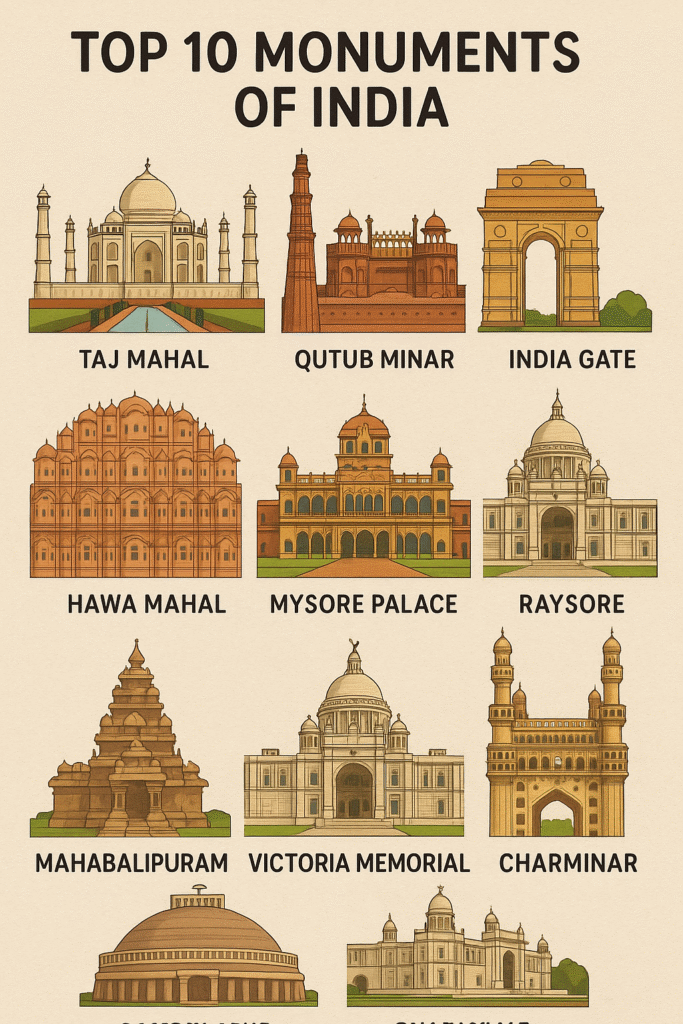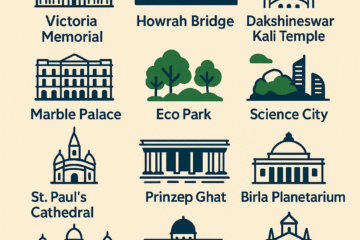
India, a land steeped in history and vibrant culture, boasts an unparalleled collection of monuments that stand as silent witnesses to its glorious past. From ancient stupas to grand Mughal mausoleums and colonial-era marvels, these structures not only showcase remarkable architectural prowess but also tell compelling stories of empires, religions, and artistic evolution. Embark on a captivating journey as we explore the top 10 monuments of India, each a testament to the nation’s enduring legacy.
1. The Taj Mahal, Agra, Uttar Pradesh
Undoubtedly the most famous and iconic of all Indian monuments, the Taj Mahal is a breathtaking white marble mausoleum located in Agra. Commissioned in 1632 by the Mughal emperor Shah Jahan to house the tomb of his beloved wife, Mumtaz Mahal, it is widely considered to be one of the most beautiful buildings in the world and a UNESCO World Heritage Site.
Historical Significance: The Taj Mahal is a poignant symbol of eternal love and devotion. Its construction took over 20 years, involving thousands of artisans and craftsmen. It represents the pinnacle of Mughal architecture, blending Persian, Islamic, and Indian styles seamlessly.
Architectural Style and Features: Built entirely of white Makrana marble, the Taj Mahal is renowned for its symmetrical design, intricate inlay work (Pietra Dura) using precious and semi-precious stones, and calligraphic inscriptions from the Quran. The central dome is flanked by four smaller domes, and four slender minarets stand at each corner of the raised platform. The surrounding gardens, with their charbagh (four-part garden) layout and reflective pools, enhance the monument’s ethereal beauty, especially at sunrise and sunset.
2. Red Fort, Delhi
A colossal red sandstone fortress, the Red Fort (Lal Qila) in Old Delhi served as the main residence of the Mughal emperors for nearly 200 years, until 1856. It was commissioned by Emperor Shah Jahan in 1638, when he decided to shift his capital from Agra to Delhi.
Historical Significance: The Red Fort is a crucial symbol of India’s struggle for independence. It was here that India’s first Prime Minister, Jawaharlal Nehru, unfurled the national flag on August 15, 1947, a tradition that continues every Independence Day. It represents the zenith of Mughal architecture under Shah Jahan and was a hub of political and cultural activity.
Architectural Style and Features: The fort’s massive defensive walls, nearly 2.5 kilometers long, enclose a complex of palaces, halls, gardens, and mosques. Notable structures include the Diwan-i-Aam (Hall of Public Audience), Diwan-i-Khas (Hall of Private Audience) with its intricate marble work and the famous Peacock Throne (now in Iran), and the beautiful Hammams (royal baths). The architectural style reflects a blend of Islamic, Persian, Timurid, and Hindu traditions.
3. Qutub Minar, Delhi
The Qutub Minar is a towering minaret and a UNESCO World Heritage Site located in Delhi. This red sandstone and marble tower stands at 73 meters (240 ft) and is a magnificent example of Indo-Islamic architecture. Its construction was started by Qutb al-Din Aibak, the founder of the Delhi Sultanate, in 1192 and completed by his successor Iltutmish.
Historical Significance: The Qutub Minar commemorates the victory of Qutb al-Din Aibak over the last Hindu kingdom of Delhi. It also signifies the beginning of Muslim rule in India. The complex surrounding it contains several historically significant monuments, including the Quwwat-ul-Islam Mosque, one of the earliest mosques in India, and the Iron Pillar of Delhi, famous for its rust-resistant composition.
Architectural Style and Features: The minaret has five distinct storeys, each marked by a projecting balcony. The lower three storeys are made of red sandstone, while the fourth and fifth are of marble and sandstone. The tower is adorned with intricate carvings and verses from the Quran. The stylistic transition from early Islamic to later Sultanate architecture is evident in the complex.
4. Humayun’s Tomb, Delhi
Predating the Taj Mahal, Humayun’s Tomb in Delhi is the tomb of the Mughal Emperor Humayun. Commissioned by his first wife and chief consort, Empress Bega Begum (Haji Begum), in 1569-70, it was the first garden-tomb on the Indian subcontinent and a precursor to the Taj Mahal.
Historical Significance: This tomb holds immense historical significance as it introduced the concept of the grand Mughal garden-tomb, setting a precedent for later Mughal architecture, most notably the Taj Mahal. It also marks a significant departure from earlier Indian tomb architecture.
Architectural Style and Features: Built primarily of red sandstone with white marble double domes and details, Humayun’s Tomb is set within a large charbagh garden, divided into four main parts by walkways and water channels. The tomb itself is octagonal in shape with high arched alcoves and intricate latticework (jali). It is a splendid example of early Mughal architecture, showcasing Persian and Indian influences.
5. India Gate, Delhi
Standing proudly at the eastern end of Rajpath in Delhi, India Gate is a monumental archway that serves as a war memorial. Designed by Sir Edwin Lutyens, it was built in 1931 to commemorate the 70,000 Indian soldiers who died fighting for the British Army during World War I.
Historical Significance: Beyond its memorial purpose, India Gate has become a significant national symbol, hosting the annual Republic Day parade. The Amar Jawan Jyoti, an eternal flame beneath the arch, was added in 1971 to commemorate soldiers who died in the Indo-Pakistani War.
Architectural Style and Features: The 42-meter-high archway is inspired by the Arc de Triomphe in Paris. It features the names of thousands of soldiers inscribed on its walls. The surrounding lawns and water features make it a popular public space and a focal point for national events. Its classical triumphal arch design stands in stark contrast to the earlier Mughal and ancient Indian styles.
6. Hawa Mahal, Jaipur, Rajasthan
The “Palace of Winds,” or Hawa Mahal, is an iconic landmark in Jaipur, Rajasthan. Built in 1799 by Maharaja Sawai Pratap Singh, it is a unique five-storey palace with a stunning façade that resembles a honeycomb.
Historical Significance: The Hawa Mahal was primarily built to allow the royal ladies to observe daily life and processions on the streets below without being seen, in accordance with the strict purdah system. It reflects the ingenuity and cultural norms of its time.
Architectural Style and Features: Constructed from red and pink sandstone, its distinctive feature is the 953 small windows (jharokhas) decorated with intricate lattice work. These windows were designed to allow cool air to circulate, creating a natural air-conditioning effect (hence “Palace of Winds”). The palace is a superb example of Rajput architecture, blending elements of Hindu and Islamic styles, particularly in its delicate carving and ornamentation.
7. Amer Fort, Jaipur, Rajasthan
Located high on a hill in Amer, a town near Jaipur, the Amer Fort (often referred to as Amber Fort) is a magnificent palace complex. Built by Raja Man Singh I in the 16th century, and later expanded by successive rulers, it is a UNESCO World Heritage Site and a prime example of Rajput architecture.
Historical Significance: Amer Fort served as the capital of the Kachwaha Rajputs for over seven centuries before the capital was moved to Jaipur. It stands as a testament to the power and grandeur of the Rajput rulers and their strategic alliances.
Architectural Style and Features: Constructed from red sandstone and marble, the fort is known for its artistic Hindu style elements. Key attractions include the Sheesh Mahal (Mirror Palace) with its intricate mirror work, the Sukh Niwas (Hall of Pleasure) where cool air is created by water flowing over a cascade, and the Ganesh Pol, an elaborately painted gate. The fort’s strategic location offering panoramic views of Maota Lake further enhances its appeal.
8. Gateway of India, Mumbai, Maharashtra
An imposing arch monument located on the waterfront of Apollo Bunder in South Mumbai, the Gateway of India was built to commemorate the landing of King George V and Queen Mary at Apollo Bunder during their
Historical Significance: While originally built to commemorate a royal visit, the Gateway of India later became a symbolic ceremonial entrance to India, particularly for British viceroys and governors. Ironically, it was also the point from which the last British troops departed India in 1948.
Architectural Style and Features: Constructed from basalt, the arch is 26 meters (85 feet) high and combines elements of Indo-Saracenic architecture (a blend of Indian, Islamic, and Western styles) with Gujarati influences. Its grand scale and prominent location overlooking the Arabian Sea make it a popular landmark and gathering point in Mumbai.
9. Victoria Memorial, Kolkata, West Bengal
The Victoria Memorial is a large marble building in Kolkata, dedicated to the memory of Queen Victoria, who was Empress of India from 1876 to 1901. Built between 1906 and 1921, it is a grand example of Indo-Saracenic revivalist architecture.
Historical Significance: Conceived by Lord Curzon, the then Viceroy of India, the memorial was intended to serve as a grand imperial monument, museum, and garden. It reflects the zenith of British colonial rule in India and houses a vast collection of artifacts from that era.
Architectural Style and Features: Designed by William Emerson, the memorial is constructed of white Makrana marble (the same as the Taj Mahal) and features a blend of British and Mughal architectural styles, with Venetian, Egyptian, and Deccan influences. It has a large dome, several smaller domes, and intricate carvings. The building is surrounded by sprawling gardens, statues, and water bodies, creating a serene and majestic atmosphere.
10. Sanchi Stupa, Sanchi, Madhya Pradesh
The Great Stupa at Sanchi, a UNESCO World Heritage Site, is one of the oldest and most significant Buddhist monuments in India. It was originally commissioned by the Mauryan emperor Ashoka the Great in the 3rd century BCE.
Historical Significance: Sanchi is central to the history of Buddhism in India. Emperor Ashoka, who embraced Buddhism after the Kalinga War, played a crucial role in its construction and expansion, making it a pivotal center for Buddhist art and architecture. It provides invaluable insights into early Buddhist iconography and narrative art.
Architectural Style and Features: The Great Stupa is a massive hemispherical dome, symbolizing the cosmos. It is surrounded by four elaborately carved gateways (toranas) facing the cardinal directions. These toranas are masterpieces of early Indian sculpture, depicting jataka tales (stories of the Buddha’s previous lives) and events from his life, without directly depicting the Buddha himself (aniconic representation). The simple yet profound architecture of the stupa, combined with the detailed artistry of the toranas, makes it a unique and spiritually significant site.
These top 10 monuments of India collectively offer a comprehensive narrative of India’s diverse historical periods, religious developments, and unparalleled artistic achievements. Each monument stands as a powerful reminder of the ingenuity and vision of its creators, inviting visitors to delve deeper into the rich tapestry of Indian heritage.

